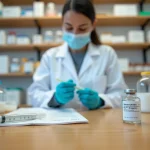Are you ready to take your home workouts to the next level?
Intense workouts can push your body to its limits, helping you build strength, and endurance, and achieve your fitness goals.
But here’s the catch – to truly master your workouts, you need to optimize your recovery time. Yes, that’s right, the secret to becoming a fitness master lies in how you recover.
Proper recovery is crucial for allowing your muscles to repair and rebuild after intense home workouts. It’s during this recovery period that your body adapts and becomes stronger.
So, if you want to maximize the benefits of your workouts and avoid burnout or injury, it’s time to pay attention to your recovery routine.
In this article, we’ll explore the key factors that can help you optimize your recovery time after intense home workouts. From nutrition and hydration to stretching and mobility exercises, we’ll provide you with practical tips and strategies to help you recover faster, so you can continue your journey towards mastery.
Get ready to take your home workouts to the next level by mastering the art of recovery!
Key Takeaways
- Proper recovery is essential for muscle repair and rebuilding after intense home workouts.
- Nutrition and hydration play a crucial role in optimizing recovery time.
- Including protein in post-workout meals is important for muscle recovery.
- Carbohydrates should be included in post-workout meals to replenish energy stores.
Importance of Proper Recovery
To optimize your recovery time after intense home workouts, you must understand the importance of giving your body proper rest and nutrition.
Your body is like a well-oiled machine, and just like any machine, it needs time to rest and recover to perform at its best. When you push your body to its limits during a workout, you’re putting stress on your muscles, joints, and cardiovascular system. Taking the time to rest and recover allows your body to repair and rebuild these tissues, making you stronger and more resilient.
In addition to rest, nutrition plays a key role in optimizing your recovery time. Fueling your body with the right nutrients is essential for replenishing energy stores and repairing damaged muscle tissue. Protein, in particular, is crucial for muscle recovery as it provides the building blocks necessary for tissue repair.
Make sure to include protein-rich foods such as lean meats, eggs, dairy, and plant-based sources like beans and lentils in your post-workout meals. Additionally, hydrating properly is important for recovery as it helps to flush out toxins and aids in the delivery of nutrients to your muscles.
Understanding the importance of proper rest and nutrition is the first step toward optimizing your recovery time after intense home workouts. By giving your body the time and resources it needs to recover, you’re setting yourself up for success in your fitness journey.
Nutrition and Hydration for Optimal Recovery
To ensure your body recovers efficiently and effectively from intense home workouts, it’s essential to focus on maintaining proper nutrition and hydration. Your body requires the right fuel and hydration to repair and rebuild muscle tissue, replenish energy stores, and optimize recovery.
Nutrition plays a crucial role in the recovery process, as it provides the necessary nutrients for muscle growth and repair. First and foremost, make sure you’re consuming an adequate amount of protein. Protein is essential for muscle recovery and synthesis, and it helps to repair and rebuild damaged muscle fibers. Aim to include a source of protein in each of your meals and snacks, such as lean meats, poultry, fish, eggs, dairy products, legumes, or plant-based protein sources like tofu or tempeh.
Additionally, don’t forget to include carbohydrates in your post-workout meals. Carbohydrates are the primary source of energy for your body, and they help replenish glycogen stores that are depleted during intense exercise. Choose complex carbohydrates like whole grains, fruits, and vegetables to provide a steady release of energy and support your recovery.
Hydration is equally important for optimal recovery. When you sweat during intense workouts, your body loses water and electrolytes that need to be replenished. Dehydration can lead to decreased performance, muscle cramps, and delayed recovery. Make sure you’re drinking enough water throughout the day, especially before, during, and after your workouts. You can use Minimal Vacuum Insulated Sports Bottle with you to keep yourself hydrated during your workout. If you’re engaging in longer or more intense exercise sessions, consider incorporating sports drinks or electrolyte-enhanced water to replace lost electrolytes.
Stretching and Mobility Exercises
After a tough workout, it’s important to incorporate stretching and mobility exercises to help prevent muscle soreness and improve overall flexibility. Stretching helps to lengthen the muscles and increase blood flow, which can reduce the buildup of lactic acid and decrease the risk of injury.
Mobility exercises, on the other hand, focus on improving joint range of motion and stability, allowing you to move more freely and efficiently during your workouts. By incorporating these exercises into your post-workout routine, you can optimize your recovery time and ensure that your body is ready for the next intense home workout.
To help you get started with stretching and mobility exercises, here are four essential moves to include in your routine:
- Hip Flexor Stretch: This stretch targets the muscles in the front of your hips and can help alleviate tightness caused by sitting for long periods. Start in a lunge position with your back knee on the ground and your front leg bent at a 90-degree angle. Lean forward slightly to feel a stretch in the front of your hip. Hold for 30 seconds on each side.
- Thoracic Spine Rotation: This exercise focuses on improving mobility in your upper back and shoulders. Start by sitting on the ground with your legs extended in front of you. Place one hand behind your head and rotate your torso towards the opposite side, reaching your elbow towards the ground. Hold for 10 seconds and repeat on the other side.
- Calf Stretch: Tight calf muscles can contribute to foot and ankle pain. Stand facing a wall and place your hands on it for support. Step one foot back, keeping your heel on the ground, and lean forward to feel a stretch in your calf. Hold for 30 seconds on each side.
- Shoulder Dislocates: This exercise helps to improve shoulder mobility and flexibility. Stand with your feet shoulder-width apart and hold a resistance band or towel in front of you with a wide grip. Lift the band overhead and behind you, keeping your arms straight. Slowly bring the band back to the starting position. Repeat for 10 reps.
Incorporating stretching and mobility exercises into your post-workout routine will not only help optimize your recovery time but also improve your overall athletic performance.
Keep practicing these moves regularly, and you’ll soon notice an improvement in your flexibility and range of motion, bringing you one step closer to mastering your home workouts.
Sleep and Rest for Muscle Repair
Get a good night’s sleep to give your muscles the chance to repair and recover from your intense home workouts. Sleep is an essential part of the recovery process, as it allows your body to produce and release growth hormone, which is crucial for muscle repair and growth. When you sleep, your body enters into a state of rest and repair, during which it can heal and rebuild the muscle fibers that were damaged during your workouts. Additionally, sleep helps to regulate your body’s cortisol levels, which can become elevated during intense exercise. Cortisol is a stress hormone that can inhibit muscle growth and recovery, so getting enough sleep is important for keeping these levels in check.
To emphasize the importance of sleep for muscle repair, here is a table that highlights the benefits of a good night’s sleep:
| Benefits of Sleep for Muscle Repair |
|---|
| 1. Enhanced muscle growth |
| 2. Improved muscle recovery |
| 3. Increased protein synthesis |
| 4. Reduced muscle soreness |
| 5. Boosted athletic performance |
As you can see, getting enough sleep not only allows your muscles to repair and recover, but it also promotes muscle growth and improves your overall athletic performance. So, make sure to prioritize sleep as part of your recovery routine and aim for 7-9 hours of quality sleep each night. This will give your muscles the time they need to rejuvenate and prepare for your next intense home workout.
Active Recovery Strategies
Engaging in active recovery strategies is like giving your body a soothing massage after a grueling workout, helping it bounce back stronger and ready for the next challenge. When you incorporate these strategies into your post-workout routine, you’ll not only optimize your recovery time but also enhance your overall performance.
Here are three effective active recovery strategies to consider:
- Low-Intensity Cardio: After a tough workout, your body may still be in a high-stress state. Engaging in low-intensity cardio activities such as walking or light cycling can help promote blood flow, reduce muscle soreness, and flush out metabolic waste. This gentle movement allows your body to recover without placing additional stress on your muscles.
- Stretching and Mobility Exercises: Flexibility and mobility play a crucial role in preventing injuries and improving overall performance. Incorporating stretching and mobility exercises into your active recovery routine can help release tension in your muscles, increase your range of motion, and promote better muscle alignment. By dedicating time to improving your flexibility and mobility, you’ll enhance your body’s ability to perform at its best.
- Active Rest: While rest days are essential for recovery, incorporating active rest can also be beneficial. Instead of completely taking a day off from physical activity, engage in light, enjoyable activities such as yoga, swimming, or leisurely bike rides. These activities not only keep you moving but also provide mental and physical relaxation, allowing your body to recover while still staying active.
By incorporating these active recovery strategies into your routine, you’ll optimize your recovery time and set yourself up for success in your fitness journey. Remember, recovery is just as important as the workout itself, and by taking care of your body, you’ll be well on your way to achieving mastery of your fitness goals.
Frequently Asked Questions
Are there any specific supplements or foods that can help speed up recovery after intense home workouts?
To optimize your recovery after intense home workouts, consider incorporating multiple supplements and foods into your routine. These can help speed up your recovery time and support your body’s natural healing process.
How long should I wait before starting another intense workout session to ensure proper recovery?
To ensure proper recovery and maximize gains, wait at least 48 hours before diving into another intense workout session. This allows your muscles to repair and rebuild, preventing injury and promoting long-term progress.
Can stretching and mobility exercises be done before and after workouts, or should they only be done during recovery?
Stretching and mobility exercises should be done both before and after workouts. They help improve flexibility, prevent injuries, and enhance performance. Incorporating them into your routine will help you master your workouts and optimize recovery.
Are there any specific sleep and rest techniques or strategies that can enhance muscle repair?
To enhance muscle repair, it’s crucial to prioritize quality sleep. Make sure to create a relaxing sleep environment and establish a consistent sleep routine. This will optimize your body’s natural recovery process and aid in muscle repair. Rest up, champ!
What are some examples of active recovery strategies that can be incorporated into my post-workout routine?
Incorporate active recovery strategies like light jogging, swimming, or yoga into your post-workout routine. These activities promote blood flow, reduce muscle soreness, and improve flexibility, ultimately enhancing your recovery and helping you achieve mastery.

















